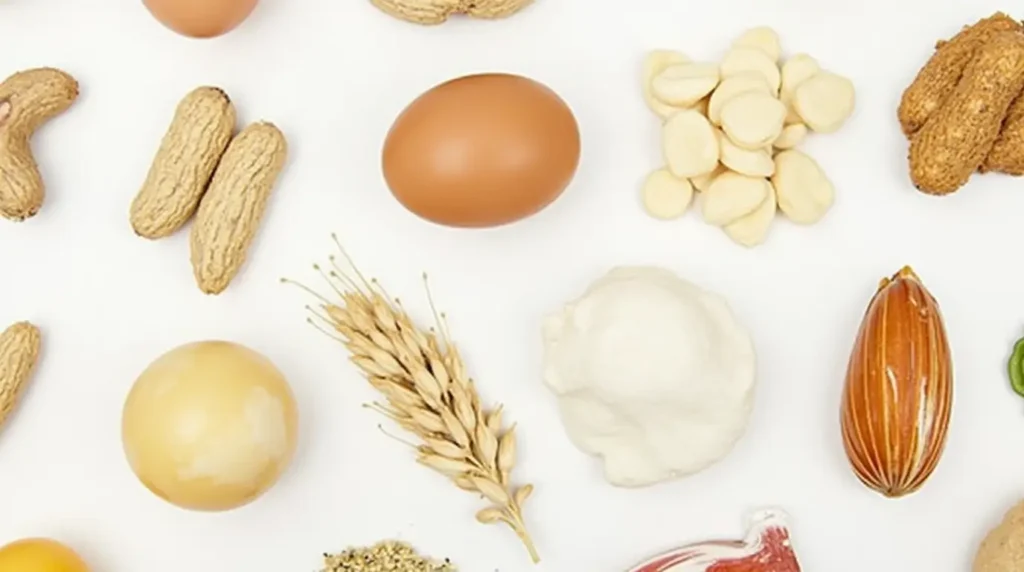Introduction:
Have you ever looked at the bewildered expression on your baby’s face as they tasted something entirely new for the first time? It’s downright magical! Watching an infant explore new textures, colors, and flavors can be as exciting as taking a vacation to an uncharted land. But let’s face it: deciding what to feed your baby can feel a bit overwhelming. Should you go for traditional Infant Food (purees…) or jump into the world of baby-led weaning? When is the right time to introduce solids? Will your tiny taster love broccoli as much as you do?
Thank you for reading this post, don't forget to subscribe!Questions like these crop up fast, and feeling uncertain is perfectly normal! In fact, the sheer variety of “infant food” options homemade, store-bought, plant-based, and allergen-friendly can be both a blessing and a bit bewildering. The good news is that feeding your baby is an incredible journey, one marked by heaps of discovery, giggles, and maybe a few wrinkles on the nose!
So, buckle up as we dive into the extraordinary world of Infant Food and feeding strategies. We’ll explore tips on transitioning to solids, unveiling bold flavor combos, blending up homemade baby meals, and so much more. Let’s get started by unraveling the basics, shall we?

The First Six Months
Many pediatric experts recommend exclusive breastfeeding or formula feeding for the first six months of life. This is a crucial period during which your child receives essential nutrients, antibodies, vitamins, minerals, and the emotional comfort that feeding brings. Yet those chubby, curious hands start to reach for your spoon, and you might be tempted to give them a tiny taste of your mashed potatoes. Is it the right time? Often, signs of readiness include sitting up with minimal support, showing an interest in what you’re eating, and losing the tongue-thrust reflex (that reflex that helps them push food out of their mouths!).
Preparing for Solids
Before jumping to purees and mashed veggies, confirming your little one is developmentally prepared for solids is important. They won’t need a feast immediately, just a small spoonful or two for a start. Introduce new foods gradually. Remember: this process isn’t just about pumping them full of nutrients and letting them explore. Whether you choose baby-led weaning or spoon-feeding purees, ensure it’s a joyful time. No one wants mealtime to become a high-stress event!
Signs They’re Ready
- Sitting Up Straight: If your baby can maintain good head and neck control, it’s a definite sign they might be ready to experiment with textures beyond milk.
- Interest in Foods: Are they staring you down when you eat? Do they try to grab that spoon of yogurt? Curiosity is a green light for “Bring on the infant food!”
- No More Tongue-Thrust Reflex: If your baby can manage to swallow a little spoonful instead of promptly pushing it out, that’s another sign it’s go-time.
Spoon-Fed Purees
Spoon-feeding has been around for a long time, and it’s something our parents and grandparents swore by. If you opt for this route, you’ll likely begin with gentle flavors of mashed bananas, steamed and pureed carrots, and smooth oatmeal. The consistency is soft and easy for them to handle. You might get some messy faces, but it’s all part of the fun!
Advantages
- Control Over Consistency: You decide how thick or thin the puree is.
- Less Mess (in Theory!): Though your little one might still fling peas across the room, spoon-feeding can be a bit tidier than baby-led weaning.
- Gradual Flavor Introduction: You control how fast you introduce new flavors.
Potential Downsides
- Less Autonomy for Baby: They’re not physically picking up foods on their own as much.
- Possibility of Overfeeding: Sometimes, it’s easy to sneak in “just one more spoonful,” even if the baby might be done.
Baby-Led Weaning
Baby-led weaning (BLW) flips the spoon-feeding script. Rather than pureeing everything, you provide soft, easy-to-grip pieces of food like steamed carrots cut into stick shapes, avocado wedges, or banana halves and let your baby feed themselves. This approach encourages babies to explore textures and flavors independently.
Advantages
- Promotes Autonomy: Your baby decides how much to eat and at what pace.
- Sensory Exploration: They feel the squishy avocado or the mushy sweet potato, stimulating curiosity and motor skills.
- Family Mealtime: Baby can share similar foods (with necessary modifications) as the rest of the family.
Challenges
- Mess Factor: Be prepared for banana smears in hair and sweet potato on the highchair, maybe even on the walls!
- Nervousness Over Gagging: Some caregivers worry about choking, but it’s typically manageable if food is cut appropriately, and you’re watching closely.
Hybrid Approaches
There’s no need to pick sides! Many parents choose a middle path, spoon-feed some meals, and let the baby experiment with self-feeding at others. It might look like giving them pureed butternut squash for lunch while letting them explore a soft piece of ripe peach at dinner. Flexibility is key. Every family is unique, and so is every baby’s feeding journey.

The Evolution of Infant Food: Beyond Plain Purees
Flavor Fusion
Who says babies can’t enjoy seasonings? When used sparingly, certain herbs and spices can excite baby meals. A dash of cinnamon in oatmeal or a tiny sprinkle of mild herbs in mashed vegetables can open the door to palate adventure.
- Sweet and Savory Combos: Mashed sweet potato with a hint of gentle curry (very gentle, mind you!) introduces unique flavors without overpowering your little one.
- Herbal Teasers: Add a pinch of rosemary or basil to pureed lentils or chicken. You’ll be amazed at how intrigued the baby might be.
Textural Twists
Babies love exploring textures, so don’t shy away from chunkier purees as they grow. Soft mashed beans, finely shredded chicken, or oatmeal with tiny fruit bits can help develop chewing skills.
- Varying the Texture: Slowly transition from silky smooth to slightly lumpy. As they handle lumps with ease, move to soft finger foods.
- Finger Food Fun: Cooked pasta spirals, soft scrambled eggs, or small chunks of banana; give them practice with pincer grips and chewing.
Homemade vs. Store-Bought
People often ask: “Is homemade better than store-bought?” It depends. Homemade baby food lets you control ingredients, freshness, and flavor. But let’s be honest, life gets busy. Sometimes, you’ll need the convenience of pre-made.
- Homemade: You can bulk-prepare and freeze purees in ice cube trays for quick defrosting. Plus, it’s cost-effective.
- Store-Bought: On hectic days, quality store-bought options with no additives can be a godsend. Just read the labels and opt for reputable brands with transparent ingredients.
Allergenic foods like peanuts, eggs, and shellfish can make new parents nervous. Recent guidelines suggest introducing potential allergens early, around four to six months, to reduce the likelihood of allergies. But always consult your pediatrician before introducing these foods, especially if there’s a family history of allergies!
Common Allergens to Watch Out For
- Peanuts
- Tree Nuts (almonds, cashews)
- Eggs
- Shellfish
- Dairy (cow’s milk products)
- Wheat
- Soy
Tips for Safe Introduction
- One Allergen at a Time: Don’t mix peanuts and eggs when testing a new allergen.
- Small Quantities: Start with a small dab, like a dab of peanut butter, thinned out with breast milk or formula.
- Observe Carefully: Watch for any reactions to hives, rash, swelling, or respiratory issues. If you see something alarming, contact your pediatrician immediately.

Navigating Nutritional Needs:
Important Nutrients
Babies grow rapidly, so they need a robust nutritional portfolio. By six months or so, iron levels from birth begin dropping, making dietary iron crucial.
- Iron: Found in fortified cereals, lean meats, beans, and spinach.
- Vitamin D: Often supplemented through pediatric drops if breastfeeding.
- Healthy Fats: Essential for brain development! Foods like avocado, full-fat dairy (once they’re old enough), and certain fish (low in mercury) can help.
Hydration and Liquid Intake
Babies get most of their hydration from breast milk or formula. Once solids come into play, you can introduce small sips of water in an open cup. Avoid juices and sweetened beverages, leading to tooth decay and extra sugar intake.
- Open Cup Practice: Offering water in a tiny, open cup can foster motor skills.
- Moderation: Don’t go overboard. Water intake should remain minimal for infants under one year, since they still rely on milk for primary hydration.
Cultural Inspirations in Infant Food:
Ever thought about broadening your baby’s culinary horizons through global flavors? From warm spices in Indian dal to mild Mediterranean herbs, the possibilities are thrilling. Of course, we keep things kind and baby-friendly, but there’s no need to stick to the same old bland options.
East Asian-Inspired Bites
- Rice Congee: A smooth rice porridge that can be mixed with mashed vegetables or tiny bits of shredded chicken.
- Miso Soup (Mild): Very mild miso can sometimes be introduced, but keep sodium levels in check.
Mediterranean Flavors
- Mashed Chickpeas (Hummus-Style): A dash of olive oil, perhaps a hint of garlic, can create a hummus-like puree.
- Soft Cooked Eggplant: The tender texture can be easily mashed and is a perfect sidekick for other pureed veggies.
Latin American Twists
- Refried Beans: Choose a low-sodium version and blend them with a bit of water or breast milk for smoothness.
- Mashed Plantains: Sweet, soft, and delicious.
Exploring different cultural recipes can spark your baby’s curiosity, expand their palate, and maybe even reduce picky-eating tendencies later on. Variety is the spice of life!
Meal Planning and Preparation:
A Day in the Life of Feeding
Planning your baby’s meals in advance can be helpful, especially if you have a busy work schedule or other children. Below is a rough sample of a day’s feeding routine once your infant is established on solids. (Remember, every baby is different, so adjust as needed!)
- Morning Milk: Breastfeed or formula-feed upon waking.
- Breakfast: Infant cereal mixed with breast milk/formula, plus a spoonful of mashed fruit (banana or pear).
- Mid-Morning Nap: Possibly a milk feed before or after, depending on the baby’s routine.
- Lunch: A puree of sweet potatoes and carrots, maybe a taste of mashed beans for protein.
- Afternoon Snack (Optional): If a baby is older, maybe a small serving of yogurt or soft fruit pieces.
- Dinner: A spoon-fed puree of chicken and vegetables or a few soft finger foods if doing baby-led weaning.
- Bedtime Milk: Breast or formula feed before sleep.
Batch Cooking and Freezing
Feeling like a short-order cook? You can reduce daily prep stress by batch cooking!
- Choose a Weekend Day: Boil or steam veggies (like carrots, peas, sweet potatoes) in large batches.
- Puree and Portion: Use an ice-cube tray to freeze puree portions. After freezing, store cubes in labeled freezer bags.
- Defrost As Needed: Pop a cube or two in a microwave-safe dish (or thaw in the fridge) for quick meals.
Meal Prep Tips
- Safety First: Always ensure clean cooking areas, utensils, and highchairs.
- Label Everything: Clearly mark containers with the date and type of food.
- Rotate Varieties: Don’t freeze 50 cubes of just carrots. Create a rainbow of options to keep the baby’s meals diverse.

Practical Feeding Tips:
Embrace the Mess
No matter the feeding approach, things will get messy. Bibs, plastic mats, and easily wipeable surfaces are your friends! Babies learn by squishing, smearing, and occasionally tossing food around like confetti. Let them have fun within reason, and keep your sense of humor close by.
Watch for Hunger and Fullness Cues
Let your baby guide you! Babies have a remarkable sense of self-regulation if they’re full, they’ll let you know by turning away or losing interest. Respect those cues to build healthy eating habits.
Patience is a Virtue
Some days, they’ll gobble down everything. On other days, they’ll clamp their little mouths shut like a vault! That’s okay. Consistency matters more than perfection. Just keep offering a range of nutritious foods.
FAQs
How often should I introduce new foods?
Is it safe to add salt or sugar to my baby’s meals?
What if my baby hates a certain food?
When can my baby start drinking cow’s milk?
How do I prevent choking?
Should I follow a strict feeding schedule?
Can I give my baby fruit juice?
Conclusion:
At the heart of it all, remember that “infant food” is not just a means to fill their tiny bellies. It’s a gateway to cultural exploration, sensory development, and quality family bonding. Through each messy spoonful, you’re helping shape an adventurous and healthy eater for the future. Whether you opt for spoon-fed purees, baby-led weaning, or a blend of both, your patience, creativity, and love will guide the way.
So, don’t be afraid to experiment with subtle herbs, offer them a rainbow of tastes, and let them take charge occasionally. You’ve got this! Feeding your baby can become one of the most memorable parts of early parenthood, so savor every squishy dribble moment. Bon appétit, little one!

